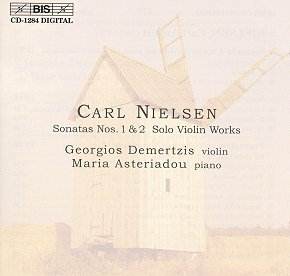From the opening the First Violin Sonata
is immediately identifiable as having been written by the young
Nielsen of the First Symphony. The work is rhapsodic, lyrical,
ecstatic, like the best of early Nielsen.
The Second Sonata is grander and more
mystical, occasionally playful, in the style of the middle and
later symphonies, with which it is contemporaneous.
The Theme And Variations is so difficult
that it has been performed rarely, but violinist Demertzis tosses
it off with utter aplomb and complete lack of struggle as if it
were the easiest thing in the world. As a result we can relax
and really enjoy it. Naturally it contains vigorous arpeggiated
passages, as well as lyrical episodes. While it is unlike other
Nielsen works it is easily accessible.
The Preludio e Presto is for "prepared
violin" as the soloist is required to apply a mute to one
string while playing on another. The work is written without key
signature or bar-lines giving it much of the character of a free
improvisation. In spite of this daring modernism for its time,
even the conservative critics were pleased.
Violinist Demertzis studied with Max Rostal and
here plays dramatically, powerfully, assuredly, with brilliant
tone. Pianist Asteriadou, a prize winner at the Maria Callas International
Piano Competition in Athens, presents the fiendishly difficult
piano parts with virtuosity, drama and beautiful tone. The two
artists work together with complete understanding and make this
music sound easy to play, which it most assuredly is not. Recording
is close and extremely accurate — one hears the dampers lifting
off the piano strings, and on one occasion one can hear the violinist
take a breath before beginning a movement. Violin tone is very
sharp, but the deepest bass seems missing from the piano sound.
Paul Shoemaker
